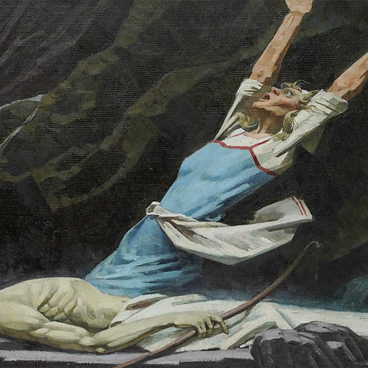Igor Gashkov was born in Petrozavodsk. From 1982 to 1986, he studied at the Viktor Vasnetsov Art and Industrial College in Abramtsevo. He majored in “artistic wood processing”. Since 1996, Gashkov has been employed as an artist-restorer at the Kizhi Museum-Reserve, working in the restoration of the collection titled “Wood”.
In Karelian art, the Kalevala series by Igor Gashkov is one of the most unique examples of artistic interpretations of the poetic text. The carved “illustrations” not only accurately depict the literary plot but also convincingly incorporate the mythology of wood, absorbing both the ancient pagan and medieval visual cultures, as well as the principles of Russian avant-garde, while naturally maintaining the transparent framework of oral folk traditions. Each work is based on a specific story from the renowned epic poem.
The main type of carving that the artist uses is flat relief, with a background that is carved to a depth of approximately one centimeter. The details of the scenes and all ornaments are created using contour carving techniques. The ornamental stripes are placed both within the scenes and along the edges of all panels, as well as sometimes on the empty field of the panel. The images are stylized and concise, yet simultaneously dynamic and clear. The dimensions of shapes and figures vary throughout the work. The ornaments resemble traditional designs, and the overall pictorial style is reminiscent of the Early Medieval period. After completion, the panels are given various shades of aged wood. The artist shapes the panels in such a way that they resemble animals, birds, fish, trees, and a shaman’s tambourine. Sometimes, in combination with the ornaments, the frame simply serves as a border around the main carvings within the scenes.
The panel on display illustrates the creation of
Sampo. In the dark expanses of Pohyola, Ilmarinen finds a place to set up his
anvil. He lights a fire and throws into the blazing furnace swan’s feathers,
milk from a heifer, wool of a summer lamb, and a grain of barley. He instructs
Louhi’s slaves to blow air onto the fire with bellows without stopping. The
slaves work the bellows day and night, tirelessly, until their heels sink into
the stones and calluses form on their hands. After three days, Ilmarinen
notices that the long-awaited mill, Sampo, has emerged from the ashes.



